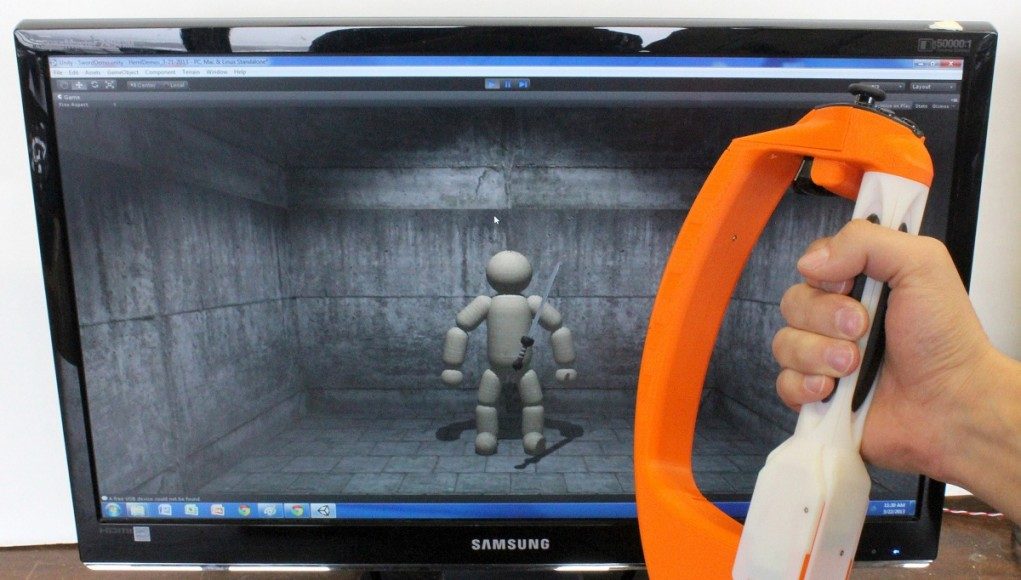At GDC 2013, a company called Tactical Haptics showed off a tactile-feedback system, called Reactive Grip, for motion-controlled input devices. The prototype I got to use consisted of a hacked up Razer Hydra built into a 3D printed housing with four sliders that move up and down in your hand as you grip the unit. For certain situations, like swinging a sword or flail, the system creates an impressively convincing sensation that could bring us one step closer to immersive virtual reality.
A Sensational Sensation

With the Reactive Grip system, translational motions and forces can be portrayed by moving the sliders in unison with the direction of force, while moving the sliders in opposite directions can create the feeling of the device wrenching in the user’s grasp.
When I asked Palmer Luckey what he thought about the system, he told me it was “totally badass.”
The sword and flail demos (see the video above) stole the spotlight for me. While the slicing motion felt good, the stabbing motion felt immediately natural. As you stab into the material, the handle of the unit seems to push back against you, as though there really is some resistance at the end of the virtual sword. Sliding the sword under the arm of the dummy and letting it slowly slide off the blade felt very convincing.
The flail demo was even better. Imagine swinging a flail over your head; think about the way that the grip of the flail would pull in a circular motion around your hand as the mass above you swings about. That sensation was very convincing with Reactive Grip. It almost felt like there really was a weight flying around above my head attached to the handle.
An Extra Layer of Immersion
Reactive Grip could provide another layer of immersion when combined with an experience like the Oculus Rift Razer Hydra ‘Tuscany’ demo. With a head mounted display, reaching out to grab objects with your own virtual hands is already highly immersive — adding realistic tactile sensation would take things to the next step.
Immediately I imagined that this would be incredible for a game like Chivalry: Medieval Warfare (PC, 2012), wherein you engage in combat using any number of medieval weapons — including a flail. Such a setup would take advantage of both motion sensing for attacks and tactile feedback when striking opponents or parrying weapons.
Founding and Future of Tactical Haptics and Reactive Grip
Tactical Haptics and the Reactive Grip technology comes out of the University of Utah’s Haptics & Embedded Mechatronics Laboratory. The company is a recent startup, founded Dr. William Provancher, which hopes to commercialize the Reactive Grip technology.
 In addition to the handle-based unit that I tried at GDC, the technology can be applied to a number of other applications, such as finger-based systems that can be built into gamepads and small tool-like implements which could provide tactile feedback for virtual surgery training.
In addition to the handle-based unit that I tried at GDC, the technology can be applied to a number of other applications, such as finger-based systems that can be built into gamepads and small tool-like implements which could provide tactile feedback for virtual surgery training.
Provancher, who holds a Ph. D. in Mechanical Engineering and is currently an Associate Professor at the University of Utah, told me that Reactive Grip is not restricted to the Razer Hydra. It could be implemented with a Wiimote, PlayStation Move, or even a new motion tracking peripheral altogether.
The company intends to launch a Kickstarter this summer to fund developer kits, expected to cost $150, though the final implementation of the technology might happen on a license basis rather than a product directly from Tactical Haptics.
Excitingly, Provancher thinks that a system incorporating Reactive Grip would only add about $50 to the price tag of an in-production motion tracking device, which I think many looking for an immersive virtual reality experience would be willing to pay for.







